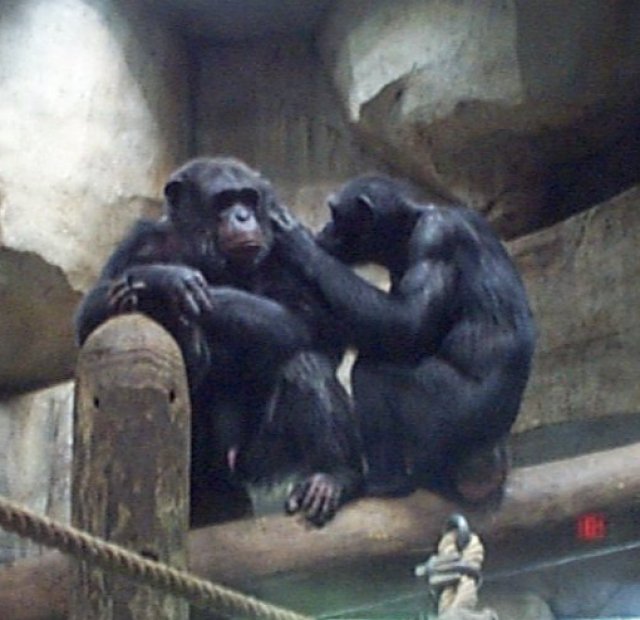 |
 |
| Bonobos | Chimpanzees |
 |
 |
| Bonobos | Chimpanzees |
| Name: Chimpanzee |
| Scientific name: Pan troglodytes (common) & Pan paniscus (pygmy chimpanzee or bonobo) |
| Range: Africa from the Altantic east to Tanzania |
| Habitat: Rain forests, mountainous rugged region, and woodland savannas |
| Status: Not threatened |
| Diet in the wild: blossoms, seeds, fruits, wasps, bird's eggs, colobus monkeys |
| Diet in the zoo: omnivore diet |
| Physical
description: A male chimp grows to about four and a half feet tall. They weigh only four pounds at birth, and about one hundred and fifty pounds at maturity. Chimps have long, thick, black body hair. They also have long arms and short legs that give the chimp a quadrupedal gait. |
| General
information: A chimpanzee is weak and helpless at birth. At two months it will start sucking its thumb and will eventually pull away from its mother. At four months it chews and swallows its first piece of food. By the time a chimp gets eighteen months it attempts to groom with adult techniques. At eight or nine years a chimp attains puberty and by the age of 15 (years) a male becomes socially mature. The behavior of a chimp's mother has an effect on the chimp's physical and social development. Chimpanzees live in groups of thirty to eighty. They are always in the process of changing composition. To obtain food, the chimps break up into small groups of about five or six. These groups vary from being all male. females and children to a mixed party of both males and females. They keep in touch with one another by calling each other with a barking noise. Chimpanzees are very unselfish. When they find food they share with the other begging chimps. Chimps are capable of hunting,
building nests and making tools. They use sticks as both weapons and
investigation probes. They use grass stems to fish for
termites. |
| Special anatomical, physiological or behavioral
adaptations: All of the males in a chimpanzee group will try to mate with each female. Therefore the father is not known. Chimpanzee mothers give birth to a single infant once every three to five years. The females chimps ovulation coincides with a week to ten-day period when she is sexually receptive to the male. This condition is known as estrus. Estrus is accompanied by a large pink swelling on the females behind that indicates she is ready to mate. |
| Comments about the lions of the Fort Worth
Zoo. The Fort Worth Zoo has two different types of chimpanzees. They have the common chimps and the bonobos. Of the common chimps, the zoo has one adult male, three adult females, one sub adult female, three juvenile males, and one infant. Of the bonobos, the zoo has three adult males. Most of the chimpanzees were born in other zoos and sent to the Fort Worth Zoo. The Fort Worth Zoo provides the chimpanzee with a proper diet and adequate space to frolic and play. They do not train or teach the primates to do tricks. However, they do train the chimps for medical purposes and teach them their body parts and shifting routines. |
| Personal Observations: When I went to the zoo the first time I saw the chimps playing with each other and jumping around just having a good ole' time. At times it did seem like they were fighting but they did not hurt one another. They seemed to perform or act silly in front of the audience. The second time that I went two of the chimps were all cuddled up and hugging & kissing each other. There was one who just lay down the whole time. He seemed to be tired. They weren't as responsive or active as the first time I saw them. |
| Page author: Brandi Williams |
 WhoZoo Home |
| Source of
information: Fort Worth Zoo Primate Keeper |